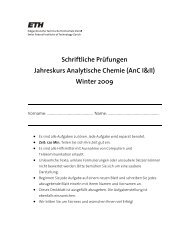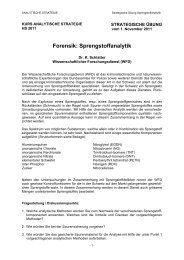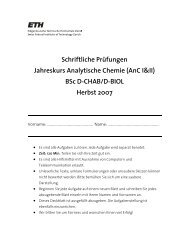individual STJ detector elements arranged in a 4-by-4 array on asingle silicon wafer. Each element is composed of two niobiumfilms separated by a thin (1.5 nm) aluminum oxide layer.The detector used here has 16 elements of 110 µm by110µmand covers an overall area of 1 mm 2 . Gaps between the individualelements create a usable area of only 20% of this area, or 0.2 mm 2of active area. Detectors designed with 200 µm by 200 µmelements have been tested and are in use in newer versions ofthe macromizer instrument, and 300 µm by300µm elements arecurrently being tested. The 300-µm size increases the effectivearea and thereby increases the sensitivity by ∼10-fold due to thefact that the ion beam is larger than the detector.Although it is theoretically possible to increase the detectorarea even further, there are several problems that limit utilizinglarger detector elements, such as manufacturing difficulties,decreased stability, increased noise, and loss of energy resolution.27 The entire detector is housed inside a magnetic field coil,which is present to suppress Cooper pair tunneling and othereffects such as Fiske resonances. 34 Each detector element is wireddirectly to its own preamplifier and data acquisition system, whichwas designed specifically for the macromizer. The sampling rateused is 20 MHz. The dynamic range is mainly limited by theanalog amplifier of the detector and is of the order of 80. Thecost and complexity of such data systems tend to limit the numberof elements within the array. It is of note that even the wirestransmitting the electrical signal must be made of an ultrathinshielded brass with superconducting niobium tips. These materialsare used because the wires must be attached directly to thedetector elements, which must be maintained at superconductingtemperatures, therefore cannot transmit excess heat and yet mustbe able of transmitting very low signals.Cryostat. Because the STJ detector measures thermal currentsand because the materials rely upon superconducting principlesto operate, it is necessary to cool the detector to temperaturesmuch below the material’s critical temperature. To maintain thesetemperatures, the detector is housed within a multistage sorptioncooler (Janis Research Co., Inc.; Wilmington, MA). The systemwas chosen because it is a closed recirculating cryostat thateliminates daily filling or maintenance and can be completelycontrolled by software. The outside shell of the cryostat is thevacuum housing, which is at room temperature. The first stageis cooled to ∼30 K using the first stage of a Gifford-McMahon(GM) cryocooler (Sumitomo Heavy Industries, Ltd., Tokyo,Japan). The next stage is attached to the second stage of the GMcold head and maintained at ∼3 K. Finally, the detector is attachedto a coldfinger and is maintained at a temperature of ∼350 mK.The coldfinger works through 3 He evaporative cooling, which isthen trapped onto charcoal. Since there is a limited amount of3He held within the coldfinger, it is necessary to regenerate thissystem every night by warming the system slightly and forcingthe liquid 3 He from the charcoal back to the coldfinger. Thisprocess takes ∼3 h and is done automatically by the computerevery night without user interference. It should be mentioned thatsmaller systems are being designed at Comet, requiring regenerationonly after several days of operation.Software and Peak Determination. A computer server thatcontrols all the operation of the macromizer instrument and(34) Fiske, M. D.; Giaever, I. P IEEE 1964, 52, 1155.archives all data is located within the lower chassis of theinstrument. To control the instrument, the user logs on to theserver via an Internet connection using the Java-based systemcontrol software. This feature also allows remote service andsupport of the instrument. The computer also controls the coolingcycle for the cryostat regeneration process and all valve and motoroperation. During experiments, the software adjusts all lasertiming, sample alignment, setting of the voltages, data acquisition,and calibration without any user intervention.Another key factor for STJ detection of ions is an algorithmfor precisely determining the time of flight and impact kineticenergy from the signal acquired by the detector. The inherentslowness of cryodetectors (peak widths of 500-600 ns) comparedto MCP detection makes it necessary to use advanced algorithmsfor determining these parameters. The algorithm used is the“turning point” method, which is specifically designed to preventdead time caused from overshoot during electronic integration.This method allows for the determination of an ion’s impact pointby applying a nine-point curve fit to the digitally differentiatedvoltage pulse. Then by first determining where the first derivativeof this curve has its maximum, the zero point can be calculated.This zero point is the turning point of the rising slope of thevoltage pulse and has a slight offset from the actual ion impacttime; however, because all pulses have a similar shape, the offsetis constant and can be accounted for in the calibration. Thecorrected zero point is used as the ion’s time of flight, which isused to calculate the m/z. The intensity can then be calculatedfrom the height of the voltage pulse, which corresponds to thekinetic energy. Laboratory measurements have shown that theoverall time resolution of the macromizer to measure moleculesof the same mass is (25 ns (based on fwhm using Ag+ isotopes,data not shown). This, in conjunction with the fact that high-massions often have large inherent spread in m/z and relatively slowdrift times (∼350 µs for 150 kDa), which allows for time-of-flightpeak resolution similar to MCP detection for masses greater than20 kDa. 35Sample Preperation. A 1 mg/mL sample of immunoglobulinG (IgG) from bovine serum (Sigma-Aldrich, Buchs, Switzerland)was dissolved in H 2 O/0.5% trifluoroacetic acid (TFA). The matrixwas sinapinic acid at 40 mg/mL in H 2 O, and the spot was layeredwith 1 µL each of matrix/sample/matrix and dried with room air.A 400 µg/mL concentration of immunoglobulin M (IgM) (BMA,Biomedicals AG; Augst, Switzerland) in H 2 O was used andprepared with the same three-layer method, using a matrix of 40mg/mL 2,6-dihydroxyacetophenone dissolved in 50% acetone/0.05% TFA, and then the spot was recrystallized using formic acid.The streptavidin sample (Sigma, Buchs) was prepared asa1mg/mL aqueous solution, mixed 1:10 with ferulic acid (40 mg/mL inethanol), and then applied as a 1-µL droplet to the sample plate.Cytochrome c (1 mg/mL, Sigma, Buchs) was measured using a1-µL layer method in sinapic acid (10 mg/mL in acetonitrile/0.1%TFA). The von Willebrand factor (vWF) was donated by Dr.Johanna Kremer Hovinga (Hemostasis Research Laboratory,University of Bern). It was purified from human blood to 80 µg/mL and analyzed after mixing 1:1 with 15 mg/mL ferulic acidmatrix.(35) Chaurand, P.; Hayn, G.; Matter, U.; Caprioli, R. M. In Proceedings of the52nd ASMS Conference on Mass Spectrometry and Allied Topics; May 23-27, Nashville, TN, 2004.4332 Analytical Chemistry, Vol. 77, No. 14, July 15, 2005
Figure 3. (a) Scatterplot of individual ion events showing time of ion impact time versus the kinetic energy of each impact. (b) A mass spectrumof IgG calculated from scatterplot a by binning points over time scale and converting time of flight to mass to charge.RESULTSFigure 3 shows an example of typical data acquired using themacromizer instrument. Figure 3a shows the data displayed asnormalized kinetic energy versus time-of-flight in microseconds(which is easily converted into mass-to-charge ratio). The y-axisvalue is created by using the voltage from each detector elementnormalized to the value for singly charged ions from that element,creating a normalized kinetic energy measurement for eachchannel. One can see that the majority of the ion signal pulseheights lie within a band between 0.8 and 1.2, corresponding tosingly charged ion events. Ions are also seen arriving in a secondintense band at a higher energy (between 1.3 and 1.8). Thesehigher kinetic energy events can be composed of either doublycharged molecules impacting the detector or pile-up (coincidence)events. In Figure 3a, there is even an intense area (at approximately210 µs and 2.2 normalized kinetic energy) that stemsfrom triply charged monomers impacting the detector at higherkinetic energies. By binning the ion signals over the mass-to-Analytical Chemistry, Vol. 77, No. 14, July 15, 2005 4333









